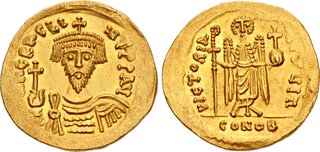| Classical Numismatic Group > Auction 126 | Auction date: 28 May 2024 |
| Lot number: 952 Price realized: This lot is for sale in an upcoming auction - Bid on this lot  | Show similar lots on CoinArchives Find similar lots in upcoming auctions on |
| Lot description: Revolt of the Heraclii. 608-610. AV Solidus (21mm, 4.48 g, 7h). Uncertain eastern mint. Crowned, draped, and cuirassed facing bust (resembling Phocas), holding globus cruciger / Angel standing facing, holding long staff surmounted by staurogram and globus cruciger; IΠ//CONOB. DOC 186 (Heraclius; Alexandria); MIB III 76 (Heraclius; Cyprus?, or eastern military mint); Bendall, Jerusalem 7 (Jerusalem?); SB 850 (Heraclius; Jerusalem). Lightly toned with some luster, minor peripheral weakness, minor marks and scratches. EF. Very rare. From the Family of Constantine Collection, assembled with guidance by Roland Michel, Geneva. Ex Glenn Woods Collection (Triton VII, 12 January 2004), lot 1094. This interesting issue belongs to the imperfectly understood subsidiary mint in the east that struck issues during the reign of Heraclius from his proclamation as emperor into the war with the Sasanian Persians. As of the present writing, no definitive conclusion have been able to be drawn regarding its location(s) and origin. Nevertheless, the use of a Phocas portrait for this type, unique for a Heraclius solidus, suggests that this issue was struck near the end of the revolt of Heraclii (circa 610) specifically within the timeframe when Heraclius the younger was proclaimed emperor but before a formal imperial imago had been prepared. This nebulous subsidiary mint, usually signed I, IX, or IΠ (there are two known examples with an Є), likely struck solidi to pay eastern troops loyal to Heraclius. It may have continued to operate sporadically after the revolt as a replacement for the mint of Antioch, which was closed by Heraclius in 610. The issues from this mint appear to terminate sometime after the Sasanian invasion of the eastern provinces in 614. The historical context during which this coin was struck was tumultuous. After Phocas deposed Maurice Tiberius, the Sasanians invaded the eastern borders of the Byzantine Empire. Byzantine-Sasanian relations had been at their zenith since Maurice supported Khosrau II's successful bid for the Sasanian throne. But once Maurice, Khosrau's ally and father-in-law, was executed by Phocas, the Sasanian king used the unfavorable change in government to launch a retaliatory invasion. The war would drag on for over two decades and span the reigns of Phocas and Heraclius from 602-628. During the conflict, Jerusalem itself fell to the Sasanian forces in 614, and Egypt was occupied for the last ten years from 618-628. The losses and recaptures of major cities and mints during this conflict muddies the waters for better understanding this eastern series. Ultimately, it remains difficult to say at which mint this series was struck, or if it belongs to a transient military mint as Bendall suggested in 2003. The very limited historical find evidence is additionally inconclusive and could equally support the Alexandrian, Levantine, or transient military mint hypotheses. Regardless of the mint's location(s), this solidus is an extremely rare issue with precious few peers, rarely seen at auction. Furthermore, it serves as a fascinating linchpin between the end of the Revolt of the Heraclii, the demise of Phocas, and the ascension of the Heraclian dynasty. Estimate: 2000 USD |  |



